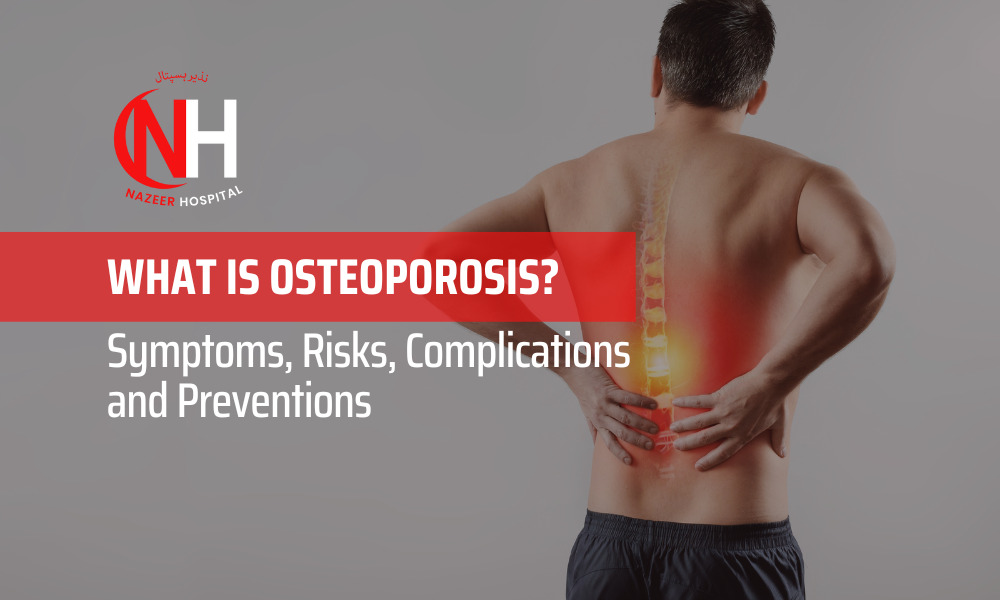Osteoporosis: Symptoms, Risks, and Prevention Strategies

Symptoms of Osteoporosis
- Loss of Height: Osteoporosis-related fractures in the spine can lead to a gradual reduction in overall height. These fractures, often called compression fractures, cause the vertebrae to collapse, contributing to a noticeable change in stature.
- Back Pain: Individuals with osteoporosis are prone to experiencing sudden or chronic back pain. This discomfort is often linked to vertebral fractures resulting from weakened bones.
- Fractures: One of the hallmark characteristics of osteoporosis is the increased risk of fractures. Even minor stresses or falls can lead to bone fractures, particularly in hip, wrist, and spine areas.
- Poor Posture: Weakening of the spinal bones due to osteoporosis can result in a characteristic stooped or hunched posture. This is often called a “dowager’s hump” or kyphosis.

When to See a Doctor
Risk Factors
Unchangeable Risks
- Hormone Levels: Women entering menopause experience declining estrogen levels, a crucial hormone in maintaining bone density. Similarly, older men may experience decreased testosterone levels, impacting bone health.
- Dietary Factors: Inadequate intake of essential nutrients, specifically calcium and vitamin D, can significantly weaken bones. Maintaining bone density and strength necessitates these vital nutrients.
- Medications and Medical Conditions: Long-term use of corticosteroids, often prescribed for asthma and rheumatoid arthritis, can accelerate bone loss. Medical conditions like celiac disease and hyperthyroidism can also elevate the risk.
- Lifestyle Choices: Certain lifestyle choices can exacerbate the risk of osteoporosis. Smoking directly weakens bones and disrupts the body’s capacity to absorb calcium. Excessive alcohol consumption and leading a sedentary lifestyle further contribute to bone deterioration.
Osteoporosis Diagnosis
Accurate diagnosis of osteoporosis involves measuring bone density. This is typically achieved through specialized tests:
- Dual-Energy X-ray Absorptiometry (DXA): This non-invasive test is the gold standard for evaluating bone mineral density. It involves a low-dose X-ray that measures bone density in specific areas, usually the hip and spine.
- Vertebral Fracture Assessment: This technique uses X-rays to detect vertebral fractures, providing crucial information for diagnosis and treatment planning.
Treatment of Osteoporosis
Although there’s no definitive cure for osteoporosis, multiple treatment choices exist to manage the condition and reduce the risk of fractures effectively:
- Medications: Healthcare professionals might recommend medications to decelerate bone loss and lower fracture risks based on an individual’s risk factors and bone density. Bisphosphonates, hormone therapy, and other bone-building drugs are standard options.
- Nutritional Supplements: Calcium and vitamin D supplements are often recommended to ensure the body receives adequate nutrients for bone health.
- Exercise:Regular physical activity is crucial for upholding optimal bone health. Weight-bearing exercises like walking, jogging, and dancing stimulate bone formation and improve bone density.
- Fall Prevention: Reducing fall risk is crucial for osteoporosis individuals. This involves adjusting the living environment to minimize hazards and practicing exercises that enhance balance and coordination.
Prevention of Osteoporosis
Prevention is the cornerstone of maintaining bone health and reducing the risk of osteoporosis. Implementing key strategies can make a significant difference in the long term:
- Balanced Diet: Consuming foods rich in calcium is fundamental to bone health. Incorporate dairy products, leafy greens, and fortified foods into your diet to ensure an adequate calcium intake. Furthermore, emphasize the consumption of vitamin D-rich foods like fatty fish and fortified dairy products to enhance calcium absorption.
- Weight-Bearing Exercises: Engage in regular weight-bearing exercises that stress bones, stimulating them to become stronger. Walking, jogging, dancing, and weightlifting are excellent for promoting bone health.

Hydrotherapy for Osteoporosis
Complications of Osteoporosis
Untreated osteoporosis can lead to several complications that significantly impact an individual’s quality of life:
- Fractures: Fragile bones are prone to fractures, especially in areas like the hip, spine, and wrist. Such fractures can lead to pain, decreased mobility, and heightened reliance on others for daily tasks.
- Chronic Pain: Fractures and bone deformities can lead to chronic pain, impairing an individual’s ability to engage in regular activities and affecting overall well-being.
- Loss of Mobility: Fractures, particularly those affecting weight-bearing bones, can limit mobility and lead to a decline in physical independence.
Conclusion
Frequently Asked Questions
Dr. Shahzeb Tahir

I am a dedicated and compassionate medical professional with expertise beyond clinical practice. With an MBBS (RMP) qualification, I have a comprehensive understanding of medical science and have harnessed this knowledge to positively impact the healthcare community.
As an accomplished doctor, I have gained valuable experience working as a House Officer at Al-Nafees Medical College and Hospital. During this period, I underwent a comprehensive internship of one year, which included rotations in various disciplines, such as General Medicine, Dermatology, General Surgery, and Gynae/Obs. This diverse experience has equipped me with a well-rounded perspective on healthcare, enabling me to better understand the complexities of patient care and the diverse needs of individuals.
In addition to my clinical duties, I have taken on the role of an author, writing articles related to medicine and healthcare. I am driven by a passion for spreading awareness and educating the masses on maintaining hygiene, promoting good health practices, and encouraging preventive measures to combat illnesses.

